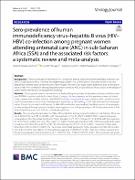| dc.contributor.author | kafeero, Hussein | |
| dc.contributor.author | Ndagire, Dorothy | |
| dc.contributor.author | Ocama, Ponsiano | |
| dc.contributor.author | Walusansa, Abdul | |
| dc.contributor.author | Sendagire, Hakim | |
| dc.date.accessioned | 2021-03-04T10:16:38Z | |
| dc.date.available | 2021-03-04T10:16:38Z | |
| dc.date.issued | 2020-10-27 | |
| dc.identifier.citation | APA | en_US |
| dc.identifier.other | https://doi.org/10.1186/s12985-020-01443-6 | |
| dc.identifier.uri | http://ir.iuiu.ac.ug/xmlui/handle/20.500.12309/746 | |
| dc.description.abstract | Background: There is plenitude of information on HIV infection among pregnant mothers attending antenatal care
(ANC) in sub-Saharan Africa. However, the epidemiology of HBV–HIV co-infections in the same cohort is not clear
despite the common route of transmission of both viruses. The aim of our study was to synthesize data on the prevalence
of HBV–HIV co-infection among pregnant women attending ANC in Sub-Saharan Africa to assist in the design of
public health interventions to mitigate the challenge.
Methods: The study was done in tandem with the Preferred Reporting Items for Systematic Reviews and Meta-analyses
(PRISMA) standards and the Cochran’s Q test, I2 statistics for heterogeneity and the prevalence were calculated
using commercially available software called MedCalcs (https ://www.medca lc.org). A random effect model was used
to pool the prevalence since all the heterogeneities were high (≥ 78%) and Phet< 0.05 indicated significant heterogeneities.
The risk factors and risk differences for HBV–HIV co-infection were analyzed. Any likely sources of heterogeneity
were analyzed through sensitivity analysis, meta-regression and sub-group analysis. All analyses were done at 95%
level of significance and a P < 0.05 was considered significant.
Results: The overall pooled prevalence of HBV–HIV co-infection among pregnant mothers in sub-Saharan Africa was
low 3.302% (95%CI = 2.285 to 4.4498%) with heterogeneities (
I2) of 97.59% (P > 0.0001). Within regional sub group
meta-analyses, West Africa had significantly higher prevalence of 5.155% (95% = 2.671 to 8.392%) with heterogeneity
(I2) of 92.25% (P < 0.0001) than any other region (P < 0.001). Articles published from 2004–2010 had significantly higher
prevalence of 6.356% (95% = 3.611 to 9.811%) with heterogeneity (I2) 91.15% (P < 0.0001) compared to those published
from 2011 to 2019 (P < 0.001). The HIV positive cohort had significantly higher prevalence of HBV–HIV co-infection of 8.312% (95% CI = 5.806 to 11.22%) with heterogeneity (I2)94.90% (P < 0.0001) than the mothers sampled from the general population with a prevalence of 2.152% (95% CI = 1.358 to 3.125%) (P < 0.001). The overall and sub group analyses had high heterogeneities ( I2 > 89%, P < 0.0001) but was reduced for South Africa (I2) = 78.4% (P = 0.0314). Age, marital status and employment were independent factors significantly associated with risk of HBV–HIV co-infection (P < 0.001) but not extent of gravidity and education level (P > 0.05). After meta-regression for year of publication and sample size for HBsAg positivity, the results were not significantly associated with HBV pooled prevalence for sample size (P = 0.146) and year of publication (P = 0.560). Following sensitivity analysis, the HBsAg pooled prevalence slightly increased to 3.429% (95% CI = 2.459 to 4.554%) with heterogeneity I2 = 96.59% (95% CI = 95.93 to 97.14%), P < 0.0001
Conclusion: There is an urgent need for routine HBV screening among HIV positive pregnant mothers attending antenatal care in sub-Saharan Africa to establish the extent of HBV–HIV co-infection in this cohort. Future studies need to investigate the putative risk factors for HBV–HIV co-infection and prioritize plausible control strategies. | en_US |
| dc.description.sponsorship | The authors declare that they did not receive any specific funding for the
study | en_US |
| dc.language.iso | en | en_US |
| dc.publisher | BMC | en_US |
| dc.relation.ispartofseries | Journal Article;17 | |
| dc.subject | Antenatal care, HBV–HIV co-infection, Pregnant mothers, Sub-Saharan Africa | en_US |
| dc.title | Sero‑prevalence of human immunodeficiency virus–hepatitis B virus (HIV– HBV) co‑infection among pregnant women attending antenatal care (ANC) in sub‑Saharan Africa (SSA) and the associated risk factors: a systematic review and meta‑analysis | en_US |
| dc.type | Article | en_US |

